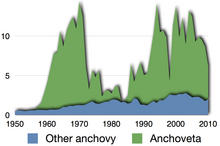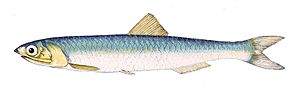Teri
| Teri | |
|---|---|

| |
| Klasifikasi ilmiah | |
| Karajaan: | |
| Filum: | |
| Kelas: | |
| Ordo: | |
| Kulawarga: | Engraulidae
|
| Genera | |
|
See text
| |

| |
| Global commercial capture of anchovy in million tonnes 1950–2010[1] | |
- Pikeun dahareun, tempoteri cué.
Teriatawa lauk teri nyaéta lauk leutik basajan nu hirup dina cai asin, biasa nu sok dijadikeun eupan, ieu lauk mangrupa jenis ti keluargaEngraulidae.
Aya 144 spésiés nu kaasup di 17 généra; sakumna téh kapanggih di diSamudra Atlantik,IndiajeungPasifik,sarta diLaut HideungjeungLaut Méditérania.lauk teri biasana diklasifikasikeun minangkalauk minyakan.[2]
Genera
[édit|édit sumber]| Généra di familiEngraulidae | ||||||
|---|---|---|---|---|---|---|
| Généra | Spésiés | Koméntar | Généra | Spésiés | Koméntar | |
| Amazonsprattus | 1 | Anchoa | 35 | |||
| Anchovia | 3 | Anchoviella | 4 | |||
| Cetengraulis | 2 | Coilia | 13 | |||
| Encrasicholina | 5 | Engraulis | 9 | Jenis génuspikeun teri: Ieu génus ngandung sakumna teri komérsil signifikan. | ||
| Jurengraulis | 1 | Lycengraulis | 4 | |||
| Lycothrissa | 1 | Papuengraulis | 1 | |||
| Pseudosetipinna | 1 | Pterengraulis | 1 | |||
| Setipinna | 8 | Stolephorus | 20 | |||
| Thryssa | 24 | |||||
Ciri mandiri
[édit|édit sumber]
Teri mah leutik, lauk héjo kalawan pantulan biru nu ditambahan ku garis horizontal warna pérak nu manjang ti dasarcécépét buntut.Jarak antara 2 nepi ka 40 cm (0,79 nepi ka 15,75 in) mun panjang teri kolot,[3]jeung bentuk awakna rupa-rupa, aya lauk nu leuwih ipis di populasi kalér mah.
Sungutna mintul kalawan huntu laleuwik nu seukeut di duacaréhamna. Sungut eusinaorgan rostral,dipiyakin miwatek sénsorik, sanajan fungsi saenyana mah teu dipikanyaho.[4]Sungutna leuwih badag batan lauk haring jeungsilversides,dua lauk nu mirip pisan jeung teri. Lauk teri ngadaharanplanktonjeung lauk nu kakara megar.
Sumebaran
[édit|édit sumber]Anchovies are found in scattered aréas throughout the world's océans, but are concentrated in temperate waters, and are rare or absent in very cold or very warm séas. They are generally very accepting of a wide range of temperatures andsalinity.Large schools can be found in shallow,brackisharéas with muddy bottoms, as in estuaries and bays. The Européan anchovy is abundant in the Mediterranéan, particularly in theAlboran Sea,[5]Aegean Seaand theBlack Sea.This species is regularly caught along the coasts ofCrete,Greece,Sicily,Italy,France,Turkey,andSpain.They are also found on the coast of northern Africa. The range of the species also extends along the Atlantic coast ofEuropeto the south of Norway.Spawningoccurs between October and March, but not in water colder than 12 °C (54 °F). The anchovy appéars to spawn at léast 100 km (62 mi) from the shore, néar the surface of the water.
Ékologi
[édit|édit sumber]The anchovy is a significant food source for almost every predatory fish in its environment, including theCalifornia halibut,rock fish,yellowtail,shark,chinook,andcoho salmon.It is also extremely important tomarine mammalsand birds; for example, breeding success of Californiabrown pelicans[6]andelegant ternsis strongly connected to anchovy abundance.
Parab
[édit|édit sumber]Lauk teri, sakumaha lolobanaclupeoids(lauk haring, lauk sardén jeung lauk teri), nyaéta eupan saringan pikeun lauk nu muka sungutna nalika ngojay. Pas cai liwat sungut jeung kaluar tinaasang,partikel kadaharan nu diayak ku asang téh dipindahkeun kanagenggerong.[7]
Spésiés komérsil
[édit|édit sumber]| Commercially significant species | ||||||||||
|---|---|---|---|---|---|---|---|---|---|---|
| Common name | Scientific name | Maximum length |
Common length |
Maximum weight |
Maximum age |
Trophic level |
Fish Base |
FAO | ITIS | IUCN status |
| European anchovy* | Engraulis encrasicolus(Linnaeus, 1758) | 20.0 cm (7.9 in) | 13.5 cm (5.3 in) | kg | 5 yéars | 3.11 | [8] | [9] | [10] | Not assessed |
| Argentine anchoita | Engraulis anchoita(Hubbs & Marini, 1935) | 17.0 cm (6.7 in) | cm | 0.025 kg (0.88 oz) | yéars | 2.51 | [11] | [12] | [13] | Not assessed |
| Californian anchovy | Engraulis mordax(Girard, 1856) | 24.8 cm (9.8 in) | 15.0 cm (5.9 in) | 0.068 kg (2.4 oz) | yéars | 2.96 | [14] | [15] | [16] | |
| Japanese anchovy | Engraulis japonicus(Temminck & Schlegel, 1846) | 18.0 cm (7.1 in) | 14.0 cm (5.5 in) | 0.045 kg (1.6 oz) | 4 yéars | 2.60 | [18] | [19] | [20] | Not assessed |
| Peruvian anchoveta | Engraulis ringens(Jenyns, 1842) | 20.0 cm (7.9 in) | 14.0 cm (5.5 in) | kg | 3 yéars | 2.70 | [21] | [22] | [23] | |
| Southern African anchovy | Engraulis capensis(Gilchrist, 1913) | 17.0 cm (6.7 in) | cm | kg | yéars | 2.80 | [25] | [26] | [27] | Not assessed |
* Type species
Pamayangan
[édit|édit sumber]Laut Hideung
[édit|édit sumber]On average, the Turkish commercial fishing fleet catches around 300,000 tons per yéar, mainly in winter. The largest catch is in November and December.[28]
Péru
[édit|édit sumber]ThePeruvian anchovyfishery isone of the largest in the world,far exceeding catches of the other anchovy species.
In 1973 it collapsed catastrophically due to the combined effects of overfishing andEl Niño[29]and did not recover fully for two decades.
Teri cué
[édit|édit sumber]
A traditional method ofprocessingandpreservinganchovies is to gut andsaltthem in brine, allow them tocure,and then pack them in oil or salt. This results in a characteristic strong flavor and the flesh turns deep grey. Pickled in vinegar, as with Spanishboquerones,anchovies are milder and the flesh retains a white color. InRomantimes, anchovies were the base for the fermented fish saucegarum.Garumhad a sufficiently long shelf life for long-distance commerce, and was produced in industrial quantities. Anchovies were also éaten raw as anaphrodisiac.[30]Today, they are used in small quantities to flavor many dishes. Because of the strong flavor, they are also an ingredient in several sauces and condiments, includingWorcestershire sauce,Caesar saladdressing,remoulade,Gentleman's Relish,manyfish sauces,and in some versions ofCafé de Paris butter.For domestic use, anchovy fillets are packed in oil or salt in small tins or jars, sometimes rolled aroundcapers.Anchovy pasteis also available.Fishermenalso use anchovies as bait for larger fish, such astunaandsea bass.
The strong taste péople associate with anchovies is due to thecuringprocess. Fresh anchovies, known inItalyasalici,have a much milder flavor.[31]InSwedenandFinland,the name anchovies is related strongly to a traditional séasoning, hence the product "anchovies" is normally made ofsprats[32]andherringcan be sold as "anchovy-spiced". Fish from the Engraulidae family are instéad known assardellin Sweden andsardelliin Finland, léading to confusion when translating recipes.
Rujukan
[édit|édit sumber]- ↑abcdBased on data sourced from the relevantFAO Species Fact Sheets
- ↑"What's an oily fish?".Food Standards Agency.2004-06-24.http:// food.gov.uk/news/newsarchive/2004/jun/oilyfishdefinitionArchived2010-12-10 diUK Government Web Archive
- ↑Froese, Rainer, and Daniel Pauly, eds. (2008)."Engraulidae"diFishBase.December vérsi 2008.
- ↑Nelson, Gareth (1998). Paxton, J.R.; Eschmeyer, W.N., ed.Encyclopedia of Fishes.San Diego: Academic Press. pp. 94–95.ISBN0-12-547665-5.
- ↑C.Michael Hogan. 2011.Alboran Sea.eds. P.Saundry & C.J.Cleveland. Encyclopedia of Earth. National Council for Science and the Environment. Washington DC
- ↑Anderson, Daniel W.; Gress, Franklin; Mais, Kenneth F.; Kelly, Paul R. (1980). North, Nance. ed."Brown pelicans as anchovy stock indicators and their relationships to commercial fishing"(PDF).CalCOFIs Reports(California Cooperative Oceanic Fisheries Investigations)21:55.http://calcofi.org/publications/calcofireports/v21/Vol_21_Anderson_etal.pdf."Pelican reproductive rate... depends largely on levels of anchovy abundance and availability."Archived2012-12-23 diWayback Machine
- ↑Bone, Q., & Marshall, N. (1982).Biology of fishes.Glasgow: Blackie.
- ↑Engraulis encrasicolus.FishBase.Ranier Froese & Daniel Pauly (éd.), vérsi April 2012. N.p.: FishBase, 2012.
- ↑Engraulis encrasicolus(Linnaeus, 1758)FAO, Species Fact Sheet. Retrieved April 2012.
- ↑Engraulis encrasicolus(TSN {{{ID}}}).Integrated Taxonomic Information System.Dibuka ping [[{{{date}}}]] [[{{{year}}}]].
- ↑"Engraulis anchoita summary page".FishBase.Diakses tanggal2017-11-16.
- ↑Engraulis anchoita(Hubbs & Marini, 1935)FAO, Species Fact Sheet. Retrieved April 2012.
- ↑Engraulis anchoita(TSN {{{ID}}}).Integrated Taxonomic Information System.Dibuka ping [[{{{date}}}]] [[{{{year}}}]].
- ↑"Engraulis mordax summary page".FishBase.Diakses tanggal2017-11-16.
- ↑Engraulis mordax(Girard, 1856)FAO, Species Fact Sheet. Retrieved April 2012.
- ↑Engraulis mordax(TSN {{{ID}}}).Integrated Taxonomic Information System.Dibuka ping [[{{{date}}}]] [[{{{year}}}]].
- ↑Citakan:IUCN2011.2
- ↑Engraulis japonicus.FishBase.Ranier Froese & Daniel Pauly (éd.), vérsi April 2012. N.p.: FishBase, 2012.
- ↑Engraulis japonicus(Temminck & Schlegel, 1846)FAO, Species Fact Sheet. Retrieved April 2012.
- ↑Engraulis japonicus(TSN {{{ID}}}).Integrated Taxonomic Information System.Dibuka ping [[{{{date}}}]] [[{{{year}}}]].
- ↑"Engraulis ringens summary page".FishBase.Diakses tanggal2017-11-16.
- ↑Engraulis ringens(Jenyns, 1842)FAO, Species Fact Sheet. Retrieved April 2012.
- ↑Engraulis ringens(TSN {{{ID}}}).Integrated Taxonomic Information System.Dibuka ping [[{{{date}}}]] [[{{{year}}}]].
- ↑Citakan:IUCN2011.2
- ↑Engraulis capensis.FishBase.Ranier Froese & Daniel Pauly (éd.), vérsi April 2012. N.p.: FishBase, 2012.
- ↑Engraulis capensis(Gilchrist, 1913)FAO, Species Fact Sheet. Retrieved April 2012.
- ↑Engraulis capensis(TSN {{{ID}}}).Integrated Taxonomic Information System.Dibuka ping [[{{{date}}}]] [[{{{year}}}]].
- ↑"Turkish Black Sea Acoustic Surveys: Winter distribution of anchovy along the Turkish coast"(PDF).Middle East Technical University Institute of Marine Sciences.
- ↑http:// ucar.edu/communications/gcip/m12anchovy/m12pdf.pdfArchived2011-12-03 diWayback Machine
- ↑"Tacitus: Germania".thelatinlibrary.
- ↑"White Anchovy Fillets (Boquerones)".marxfoods.
- ↑"Food: First catch your anchovies".The Independent.
Bacaan salajengna
[édit|édit sumber]- Chavez FP, Ryan J, Lluch-Cota SE and Ñiquen CM (2003)From Anchovies to Sardines and Back: Multidecadal Change in the Pacific OceanScience 229(5604)217–221.
- Froese, Rainer, and Daniel Pauly, eds. (2006)."Engraulidae"diFishBase.January vérsi 2006.
- Miller DJ (1956)"Anchovy"Archived2020-07-16 diWayback MachineCalCOFI Reports,5:20–26.
- Nizinski MS and Munroe TA (1988) FAO species catalogue, volume 2:Clupeoid Fishes of the World,Engraulidae,Anchovies[tumbu nonaktif]Pages 764–780, FAO Fisheries Synopsis125,Rome.Galat skrip: tidak ada modul tersebut "Catalog lookup link".Galat skrip: tidak ada modul tersebut "check isxn".92-5-102340-9.
- Pacific States Marine Fisheries Commission[1]Northern Anchovy




